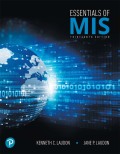
EBK ESSENTIALS OF MIS,
13th Edition
ISBN: 8220106778494
Author: LAUDON
Publisher: PEARSON
expand_more
expand_more
format_list_bulleted
Question
Chapter 8, Problem 2RQ
Program Plan Intro
System vulnerability:
- When huge data amounts are been kept in electronic form, it becomes susceptible to many threats.
- The
information systems in many locations are been interconnected through communication networks. - The unauthorized access can occur at many access points in network and is not limited to single location.
- The data flowing over networks could be accessed; valuable information could be stolen while transmission or data could be altered without authorization.
- The denial-of-service attacks are launched by intruders to disrupt website operations.
- Internets are vulnerable than internal networks as it is open to everyone.
Explanation of Solution
Security and control and government regulatory requirements:
- The legal actions that require electronic evidence as well as computer forensics may make firms to be attentive on security as well as records management.
- Computer forensics denotes scientific gathering, confirmation, safeguarding and data analysis.
- It is used in a way that information could be utilized as proof in court of law.
- The problems that are dealt are shown below:
- o Data recovery while conserving integrity.
- o Secure storage and handling of recovered media...
Expert Solution & Answer
Want to see the full answer?
Check out a sample textbook solution
Students have asked these similar questions
Using R language
using r language
using r language
Chapter 8 Solutions
EBK ESSENTIALS OF MIS,
Ch. 8.1 - Prob. 1CQ1Ch. 8.1 - Prob. 2CQ1Ch. 8.1 - Prob. 3CQ1Ch. 8.1 - Prob. 4CQ1Ch. 8.4 - Prob. 1CQ2Ch. 8.4 - Prob. 2CQ2Ch. 8.4 - Prob. 3CQ2Ch. 8.4 - Prob. 4CQ2Ch. 8 - Prob. 1IQCh. 8 - Prob. 2IQ
Ch. 8 - Prob. 3IQCh. 8 - Prob. 4IQCh. 8 - Prob. 5IQCh. 8 - Prob. 1RQCh. 8 - Prob. 2RQCh. 8 - Prob. 3RQCh. 8 - Prob. 4RQCh. 8 - Prob. 5DQCh. 8 - Prob. 6DQCh. 8 - Prob. 7DQCh. 8 - Prob. 8HMPCh. 8 - Prob. 9HMPCh. 8 - Prob. 11CTPCh. 8 - Prob. 12CTPCh. 8 - Prob. 13CSQCh. 8 - Prob. 14CSQCh. 8 - Prob. 15CSQCh. 8 - Prob. 16CSQCh. 8 - Prob. 17MLMCh. 8 - Prob. 18MLM
Knowledge Booster
Similar questions
- I need help in explaining how I can demonstrate how the Laplace & Inverse transformations behaves in MATLAB transformation (ex: LIke in graph or something else)arrow_forwardYou have made the Web solution with Node.js. please let me know what problems and benefits I would experience while making the Web solution here, as compared to any other Web solution you have developed in the past. what problems and benefits/things to keep in mind as someone just learningarrow_forwardPHP is the server-side scripting language. MySQL is used with PHP to store all the data. EXPLAIN in details how to install and run the PHP/MySQL on your computer. List the issues and challenges I may encounter while making this set-up? why I asked: I currently have issues logging into http://localhost/phpmyadmin/ and I tried using the command prompt in administrator to reset the password but I got the error LOCALHOST PORT not found.arrow_forward
arrow_back_ios
SEE MORE QUESTIONS
arrow_forward_ios
Recommended textbooks for you
 Enhanced Discovering Computers 2017 (Shelly Cashm...Computer ScienceISBN:9781305657458Author:Misty E. Vermaat, Susan L. Sebok, Steven M. Freund, Mark Frydenberg, Jennifer T. CampbellPublisher:Cengage Learning
Enhanced Discovering Computers 2017 (Shelly Cashm...Computer ScienceISBN:9781305657458Author:Misty E. Vermaat, Susan L. Sebok, Steven M. Freund, Mark Frydenberg, Jennifer T. CampbellPublisher:Cengage Learning Principles of Information Systems (MindTap Course...Computer ScienceISBN:9781285867168Author:Ralph Stair, George ReynoldsPublisher:Cengage Learning
Principles of Information Systems (MindTap Course...Computer ScienceISBN:9781285867168Author:Ralph Stair, George ReynoldsPublisher:Cengage Learning Management Of Information SecurityComputer ScienceISBN:9781337405713Author:WHITMAN, Michael.Publisher:Cengage Learning,
Management Of Information SecurityComputer ScienceISBN:9781337405713Author:WHITMAN, Michael.Publisher:Cengage Learning, Principles of Information Systems (MindTap Course...Computer ScienceISBN:9781305971776Author:Ralph Stair, George ReynoldsPublisher:Cengage Learning
Principles of Information Systems (MindTap Course...Computer ScienceISBN:9781305971776Author:Ralph Stair, George ReynoldsPublisher:Cengage Learning Fundamentals of Information SystemsComputer ScienceISBN:9781305082168Author:Ralph Stair, George ReynoldsPublisher:Cengage Learning
Fundamentals of Information SystemsComputer ScienceISBN:9781305082168Author:Ralph Stair, George ReynoldsPublisher:Cengage Learning

Enhanced Discovering Computers 2017 (Shelly Cashm...
Computer Science
ISBN:9781305657458
Author:Misty E. Vermaat, Susan L. Sebok, Steven M. Freund, Mark Frydenberg, Jennifer T. Campbell
Publisher:Cengage Learning

Principles of Information Systems (MindTap Course...
Computer Science
ISBN:9781285867168
Author:Ralph Stair, George Reynolds
Publisher:Cengage Learning

Management Of Information Security
Computer Science
ISBN:9781337405713
Author:WHITMAN, Michael.
Publisher:Cengage Learning,


Principles of Information Systems (MindTap Course...
Computer Science
ISBN:9781305971776
Author:Ralph Stair, George Reynolds
Publisher:Cengage Learning

Fundamentals of Information Systems
Computer Science
ISBN:9781305082168
Author:Ralph Stair, George Reynolds
Publisher:Cengage Learning